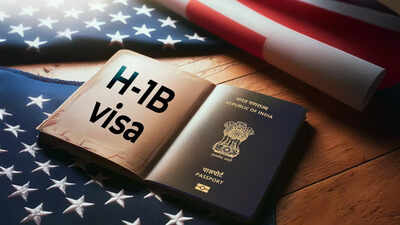ARTICLE AD BOX

As the primary recipients of the H1-B programme, Indian nationals were particularly impacted by visa rejections. (AI image)
NEW DELHI: If you are an H-1B visa applicant or aspirant, it’s important to be prepared for longer wait times, higher denial rates, and ‘novel issues’. Immigration experts suggest that H-1B visa applicants to the United States should anticipate higher rejection rates, extended processing periods and additional paperwork requirements during US President Donald Trump's second term.The application submission deadline for this fiscal year was extended by 24 hours last week, following technical issues experienced by applicants.The USCIS selected 120,141 applications through a lottery system in March from the total registrations received. The H-1B visa programme has an annual cap of 85,000 visas.
H-1B Visa: What Should Indians Be Prepared For?
A Pew Research Centre study revealed that strict evaluation of H-1B applications led to a 15% rejection rate in 2018 under the first Trump administration.
The rejection rate decreased to 3% during the Biden administration's tenure.As the primary recipients of the H1-B programme, utilised by both Indian and American organisations for US worker deployment, Indian nationals were particularly impacted by visa rejections.Also Read | What is EB-5 visa? With Donald Trump administration cracking down on student visas, Indians explore this route for a path to Green CardWait times are expected to increase, similar to patterns observed during Trump's initial presidency, according to Boundless Immigration founder Xiao Wang.
Joel Yanovich, an immigration solicitor at Murthy Law Firm, told ET: "We do expect to eventually start seeing increased scrutiny of H-1B petitions. Given what we saw during Trump's first term in office, and the administration's general scepticism of the positive impact of immigration, it is important to be prepared for what is very likely coming."Immigration platform Jeelani Law Firm notes that USCIS processing durations extended by 12-36 months during 2016-2020, when Donald Trump served his first term as president.Beyond extended processing periods, Wang highlights an uptick in requests for evidence (RFE), requiring additional documentation. Industry specialists are readying themselves for this development.The Visa Code founder Gnanamookan Senthurjothi had earlier told ET that alongside RFEs, the post-approval visa stamping and issuance process has lengthened, stretching from a few days to approximately four weeks.Yanovich from Murthy Law Firm acknowledged the increased difficulties in visa stamping and unexpected modifications in H1B petition evaluations, particularly regarding end-client documentation requirements during Trump's initial presidential term."Perhaps more concerning, however, was how novel issues started popping up during Trump's first term. For instance, in 2017, the administration issued a memo that resulted in the USCIS routinely questioning H1B petitions for wage level 1 positions.
My recommendation is to operate under the assumption that the H-1B petition will face added scrutiny and prepare accordingly," he said according to the financial daily.Also Read | ‘Like H-1B without a lottery’: What is O-1 visa? New route to US becomes popular among Indians; check details
What’s the alternative to H-1B?
With heightened examination, applicants are exploring different visa options, including L-1 for temporary intracompany transfers to the US, and investment-based EB-5 visas.Immigration specialists report that EB-5 applications have increased by 50% since January.
Additionally, there is growing interest in L-1 visas and O-1 visas, designed for individuals with exceptional abilities or significant achievements in their respective fields.Yanovich noted that whilst this increased interest partly stems from unsuccessful H-1B lottery participants, it also reflects employers and individuals seeking to avoid H-1B complications.Some candidates are also pursuing EB-2 NIW (National Interest Waiver), a category designated for advanced degree holders working in roles beneficial to US national interests.



.png)
.png)
.png)
















 4 hours ago
3
4 hours ago
3









 English (US) ·
English (US) ·